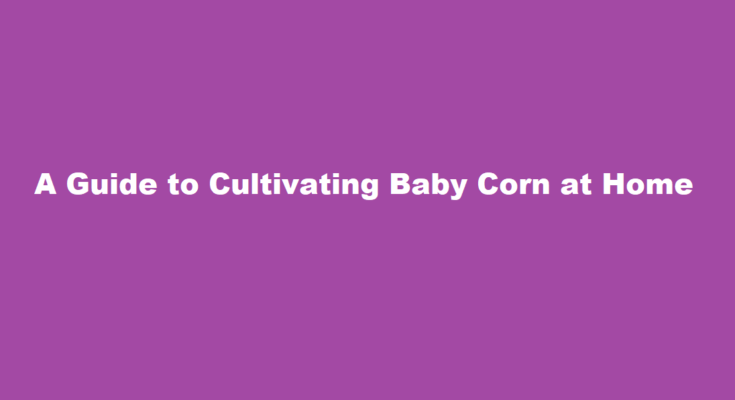Introduction
Baby corn, with its delicate texture and sweet flavor, is a delightful addition to various culinary dishes. While it is commonly found in stir-fries and salads, it can be quite expensive in stores. The good news is that you can easily grow baby corn at home, even if you have limited gardening experience. In this comprehensive guide, we will take you through the steps required to cultivate your very own baby corn, ensuring a fresh and sustainable supply for your kitchen.
Getting Started
Before you embark on your baby corn-growing journey, it’s important to gather the necessary materials. You will need seeds, a suitable location for planting, quality soil, compost, and gardening tools. Select a sunny spot in your garden or on your balcony that receives at least 6-8 hours of sunlight daily. Make sure the soil is well-drained and rich in organic matter.
Choosing the Right Seeds
When it comes to selecting baby corn seeds, you can either purchase them from a local nursery or order them online. Opt for hybrid baby corn varieties, as they tend to produce higher yields and have better disease resistance. Before planting, soak the seeds in water for a few hours to improve germination rates.
Planting
Planting baby corn is relatively straightforward. Create rows with about 8-12 inches of spacing between each plant. Sow the seeds at a depth of 1-1.5 inches, placing them about 4-6 inches apart within the row. Water the soil thoroughly after planting to ensure proper moisture.
Caring for Your Baby Corn
Baby corn requires consistent care throughout its growing season. Here are some essential steps
- Watering – Keep the soil consistently moist, but avoid overwatering, as this can lead to root rot. Water in the morning to prevent fungal diseases.
- Fertilization – Use a balanced, slow-release fertilizer to provide essential nutrients. Apply fertilizer when the plants are about 6 inches tall and again when they start producing corn.
- Mulching- Apply a layer of organic mulch to conserve moisture, suppress weeds, and maintain an even soil temperature.
- Pest and Disease Management – Keep an eye out for common pests like aphids and caterpillars. Use natural remedies or pesticides as needed. Also, watch for signs of fungal or bacterial diseases and treat them promptly.
Harvesting
Baby corn is ready to be harvested when the ears are about 2-4 inches long and the kernels are still tender. Typically, this occurs around 50-60 days after planting. Use a sharp knife to cut the baby corn from the stalk, and be sure to harvest regularly to encourage continuous production.
Frequently Asked Questions
How do baby corn grow?
The miniature size of baby corn makes consumers think that it grows from dwarf corn plants. But the tiny ears of baby corn are simply immature ears from regular-sized plants, said Jim Myers, Oregon State University vegetable breeder.
How do you take care of a baby corn plant?
Keep your container of baby corn plants in a warm and well-lit part of your house. Water regularly, and pay very close attention to the soil moisture levels. Plants grown in containers tend to dry out much quicker than those grown in your garden, so check the soil daily.
Conclusion
Growing baby corn at home can be a rewarding and cost-effective endeavor. With the right seeds, proper care, and a little patience, you can enjoy fresh, crunchy baby corn in your favorite dishes. So, roll up your sleeves, get your gardening gear ready, and embark on this exciting journey of cultivating baby corn right in your own backyard or balcony garden. Happy gardening!
Read Also : Crafting Comfort A Step-by-Step Guide to Making Homemade Vegetable Soup



